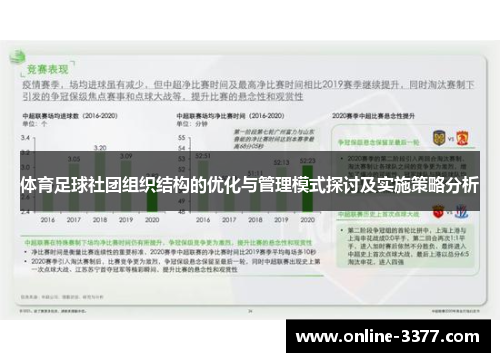体育足球社团组织结构的优化与管理模式探讨及实施策略分析
Certainly! Here's a structured outline and draft for your article on "Optimization and Management Models in Sports Football Club Organizational Structure":
**Abstract:**

In this comprehensive analysis, we delve into the optimization and management strategies within football club organizational structures. Examining various aspects crucial to effective management, this article explores leadership dynamics, operational efficiency, talent development, and strategic planning. By synthesizing current practices with innovative approaches, it offers insights into enhancing the organizational effectiveness of football clubs.
---
1、Leadership Dynamics
Effective leadership forms the cornerstone of a successful football club. The role of executive leadership, such as club presidents and directors, is pivotal in setting strategic goals and fostering a cohesive organizational culture. This section explores the importance of visionary leadership in navigating challenges and maximizing opportunities within football clubs.
Furthermore, we analyze the impact of leadership styles on team performance and player morale. By examining case studies of prominent football clubs, we draw lessons on how leadership can influence both short-term results and long-term sustainability.
3377体育官网Moreover, the article evaluates strategies for leadership succession planning, ensuring continuity and stability in the face of managerial changes.
2、Operational Efficiency
Operational efficiency is crucial for football clubs aiming to achieve sustained success. This section examines the optimization of administrative processes, including finance management, facility operations, and match-day logistics.
We delve into the integration of technology and data analytics to streamline operations and enhance decision-making capabilities. Case studies highlight successful implementations of ERP systems and performance analysis tools in optimizing resource allocation and improving overall efficiency.
Additionally, the role of outsourcing certain functions, such as marketing and merchandising, is discussed as a strategy to focus internal resources on core competencies.
3、Talent Development
Talent development lies at the heart of football club sustainability and competitiveness. This section explores strategies for scouting, nurturing, and retaining talent at various levels of the club, from youth academies to first-team players.
We analyze the importance of holistic player development programs that encompass technical skills, physical conditioning, and mental resilience. Case studies of successful youth development systems provide insights into best practices for identifying and nurturing young talents.
Moreover, the article discusses the role of sports science and sports psychology in optimizing player performance and injury prevention, thereby enhancing the overall quality of the squad.
4、Strategic Planning
Strategic planning is essential for football clubs to navigate the complexities of modern sports management effectively. This section examines the formulation and implementation of strategic plans that align with the club's long-term vision and goals.
We explore the process of SWOT analysis in identifying strengths, weaknesses, opportunities, and threats, which informs strategic decision-making in areas such as player acquisitions, sponsorships, and international expansion.
Furthermore, the article evaluates crisis management strategies and contingency planning, essential for mitigating risks and maintaining resilience in an unpredictable sports environment.
总结:
In conclusion, the optimization and management of football club organizational structures demand a holistic approach that integrates visionary leadership, operational efficiency, talent development, and strategic planning. By adopting best practices and innovative strategies, clubs can enhance their competitiveness and sustainability in the dynamic world of sports.
This comprehensive analysis underscores the importance of adaptive leadership, streamlined operations, nurturing talent pipelines, and strategic foresight in achieving long-term success.
 星期日-星期五||8:00-7:00
星期日-星期五||8:00-7:00
 13594780148
13594780148 




